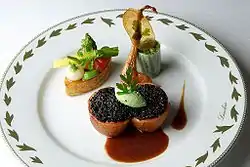Haute cuisine
Haute cuisine (French: [ot kɥizin]; lit. 'high cooking') or grande cuisine is the cuisine of "high-level" establishments, gourmet restaurants and luxury hotels. Haute cuisine is characterized by the meticulous preparation and careful presentation of food at a high price.

Early history
Haute cuisine developed out of political and social changes in France. The "high" cuisine represented a hierarchy in 17th century France as only the privileged could eat it. Haute cuisine distinguished itself from regular French cuisine by what was cooked and served such as foods like tongue and caviar, by serving foods such as fruit out of season, by making it difficult and time-consuming to cook, and by using exotic ingredients not typically found in France.[1]
In addition to who was eating haute cuisine and what exactly it consisted of, the term can also be defined by who was making it and how they were doing so. Professionally trained chefs were quintessential to the birth of haute cuisine in France. The extravagant presentations and complex techniques that these chefs were known for required ingredients, time, equipment, and therefore money. For this reason, early haute cuisine was accessible to a small demographic of rich and powerful individuals. Not only were professional chefs responsible for building and shaping haute cuisine, but their role in the cuisine was what differentiated it from regular French cuisine.[2]
Haute cuisine was characterized by French cuisine in elaborate preparations and presentations served in small and numerous courses that were produced by large and hierarchical staffs at the grand restaurants and hotels of Europe. The cuisine was very rich and opulent with decadent sauces made out of butter, cream, and flour, the basis for many typical French sauces that are still used today.[3] The 17th-century chef and writer La Varenne marked a change from cookery known in the Middle Ages, to somewhat lighter dishes, and more modest presentations. In the following century, Antonin Carême also published works on cooking, and although many of his preparations today seem extravagant, he simplified and codified an earlier and even more complex cuisine.
Cuisine classique
Georges Auguste Escoffier is a central figure in the modernisation of haute cuisine as of about 1900, which became known as cuisine classique. These were simplifications and refinements of the early work of Carême, Jules Gouffé and Urbain Dubois. It was practised in the grand restaurants and hotels of Europe and elsewhere for much of the 20th century. The major developments were to replace service à la française (serving all dishes at once) with service à la russe (serving meals in courses) and to develop a system of cookery, based on Escoffier's Le Guide Culinaire, which formalized the preparation of sauces and dishes. In its time, it was considered the pinnacle of haute cuisine, and was a style distinct from cuisine bourgeoise (the cuisine of affluent city dwellers), the working-class cuisine of bistros and homes, and cuisines of the French provinces.

Nouvelle cuisine
The 1960s were marked by the appearance of nouvelle cuisine, as chefs rebelled from Escoffier's "orthodoxy" and complexity. Although the term nouvelle cuisine had been used in the past, the modern usage can be attributed to authors André Gayot,[4] Henri Gault, and Christian Millau, who used nouvelle cuisine to describe the cooking of Paul Bocuse, Alain Chapel, Jean and Pierre Troisgros, Michel Guérard, Roger Vergé and Raymond Oliver, many of whom were once students of Fernand Point.[5]
In general, nouvelle cuisine puts an emphasis on natural flavours, so the freshest possible ingredients are used, preparation is simplified, heavy sauces are less common, as are strong marinades for meat, and cooking times are often reduced. Nouvelle cuisine was a movement towards conceptualism and minimalism and was a direct juxtaposition to earlier haute cuisine styles of cooking, which were much more extravagant. While menus were increasingly short, dishes used more inventive pairings and relied on inspiration from regional dishes.[5]
Within 20 years, however, chefs began returning to the earlier style of haute cuisine, although many of the new techniques remained.[5]
References
| Look up haute cuisine in Wiktionary, the free dictionary. |
- Sidney W. Mintz (1996). "Cuisine: High, Low, and Not at All". Tasting Food, Tasting Freedom: Excursions into Eating, Culture, and the Past. Boston: Beacon Press. pp. 92–134. ISBN 978-0807046296.
- Amy B. Trubek (2000). Haute Cuisine: How the French Invented the Culinary Profession. Philadelphia: University of Pennsylvania Press. ISBN 978-0812217766.
- Allen S. Weiss (2001). "Tractatus Logico-Gastronomicus". In Lawrence R. Schehr; Allen S. Weiss (eds.). French Food: On the Table, on the Page, and in French Culture. New York: Routledge. pp. 229–241. ISBN 978-0415936286.
- André Gayot, "Of Stars and Tripes: The True Story of Nouvelle Cuisine"
- Mennel, Stephan. All Manners of Food: eating and taste in England and France from the Middle Ages to the present. 2nd ed., (Chicago: University of Illinois Press, 1996), 163-164.
Further reading
- Cooking, Cuisine and Class, A Study in Comparative Sociology, Jack Goody, University of Cambridge, June 1982, ISBN 978-0-521-28696-1
- Food and love: a cultural history of East and West By Jack Goody, Verso (April 1999), ISBN 978-1-859-84829-6
- Tasting food, tasting freedom: excursions into eating, culture, and the past by Sidney Wilfred Mintz Beacon Press (1997) - ISBN 0-8070-4629-9
- Viandier attributed to Guillaume Tirel dit Taillevent, medieval manuscript
- Haute Cuisine: How the French Invented the Culinary Profession By Amy B. Trubek, University of Pennsylvania Press (December 2000), ISBN 978-0-8122-1776-6
- Food culture in France By Julia Abramson, Greenwood Press (November 2006), ISBN 978-0-313-32797-1
- Patrick Rambourg, Histoire de la cuisine et de la gastronomie françaises, Paris, Ed. Perrin (coll. tempus n° 359), 2010, 381 pages. ISBN 978-2-262-03318-7